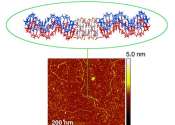Researchers shed new light on the origins of Earth's water
Water covers more than two-thirds of Earth's surface, but its exact origins are still something of a mystery. Scientists have long been uncertain whether water was present at the formation of the planet, or if it arrived ...







